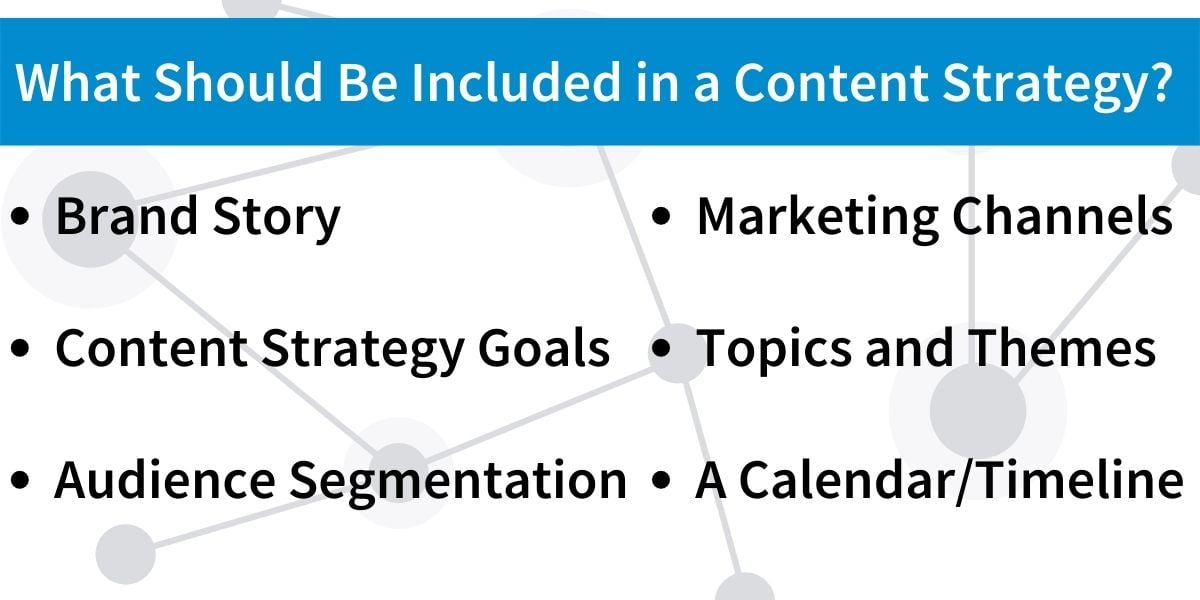"We don't advertise, at all,” says Howdy Holmes, President and CEO of the company that makes Jiffy mix. “No coupons, no sample packaging, no billboards, no radio, no TV, no celebrity endorsements. Nothing." As much as we all wish we could be providing a low cost baking staple that flies off the shelf with no advertising, the truth is that none of us are in the same position as Jiffy mix. In order to move our products or sell our services, advertising and marketing is a fact of life. And, in today’s world, most of us have turned to content marketing. This inbound marketing technique attracts customers by providing them with the information they’re looking for. By giving valuable insights around the topics that customers are interested in, businesses can establish themselves as an authority. This, in turn, funnels leads into the sales pipeline.
However, in order to do content marketing well, you need a strong content marketing strategy. What is content strategy? Well, in this brief guide, we’ll answer that question as well as help you create one and even provide a free template for you to use. Let’s get started.
What Is a Content Marketing Strategy?
A content marketing strategy is the approach you take when figuring out who to target, what content to create, when to distribute it, and which channels to use. Think of it like your itinerary—when planning a complicated trip with many different destinations, you would want to put together a plan that includes all the details, like where you’re staying the night and what time your flights are. A content strategy is similar because it is the framework of your content, but not the content itself.

What Are the 3 Components of Content Strategy?
There are, of course, more than three components that go into making a content strategy, but these three are core to creating a good one. In order to create a strong content strategy, you need to:
- Know who your target audience is and be able to discern who your best customers are within that audience.
- Anticipate how and where your customers will go to find answers to their questions.
- Provide immediate solutions with informative, engaging, and authoritative content.
These three elements will help you put together strategies and campaigns that do what you need them to: attract leads and retain customers.
What Should Be Included in a Content Strategy?
With those three elements top of mind, it’s important to remember all the other bits and bobs that should be incorporated. Your content strategy should include:
- Brand Story - Think about what differentiates your brand from others and include the value propositions that are important to share. Developing a style guide can also help keep all the content aligned with your brand.
- Content Strategy Goals - An important element, you should set SMART (Specific, Measurable, Achievable, Relevant, and Time-Bound) goals that will give you something to reach for and a way to evaluate if your content strategy was successful.
- Audience Segmentation - It’s important to identify the different types of people you’re targeting and formulate content that is personalized for those demographics.
- Marketing Channels - Consider which outlets you’ll use to distribute your content, like your website, social media, email, etc. You may want to include objectives or key performance indicators (KPIs) that are specific for each channel.
- Topics and Themes - For your content campaigns, you may want to have some topics and themes picked out (like seasonal topics or themes around a specific product that will be released) to help keep your content aligned and relevant to your brand.
- A Calendar/Timeline - It’s important to stay on track and without a timeline, it’s easy to get bogged down with all the details. Grab a calendar and map out your important dates. Be sure to consider the ideal frequency of posting for each channel as well as looking at product releases or big announcements your brand may have coming up. Be sure to set due dates and deadlines to keep everyone accountable.
 Content Strategy Example
Content Strategy Example
One brilliant example of a content strategy is IKEA—yes, the place you go to buy furniture and meatballs (and maybe get lost inside the store). Their content marketing strategy spans across multiple channels, focusing on visual social media sites like Pinterest and Youtube, intentionally showing how their products fit into their customers’ lives. For example, they have created the Smörgås Pinners Pinterest page where IKEA employees can contribute to building visual inspiration boards(“Smörgås boards”) for public consumption. Rooted in nostalgia, these boards feature IKEA products from the past through the present, showing how these products help improve people’s lives.
Another successful content strategy has been to create “How To Build” assembly videos. We’ve all heard the jokes about IKEA furniture being so simple and yet so difficult to put together correctly. Some of us have even experienced the frustration of having three little thingies leftover or a bunch of doodads that definitely can’t fit where the picture says they go. IKEA identified this pain point, and created a content marketing campaign to address it. They put together “How To Build” videos that showed step-by-step how to put their furniture together. To make these videos more versatile, they did not include a voiceover but had superimposed text that could easily be translated into any language.
As you can see from this example, content strategy will vary depending on your unique business. What works for IKEA won’t necessarily work for a Jiffy mix or your unique company. It’s important to identify both the aspirations and the pain points of your audience so you can effectively target them.
How To Create a Content Strategy
Alright, it’s time to get into the nuts and bolts of how you actually make a content strategy.
Research, Research, Research!
First and foremost, you need to do your research. This will be split over several different categories:
- Audience - Who is your target audience? What demographics are you attracting with your current efforts and is that the same or different from the people you want to be reaching? There is a lot of valuable information you can glean from examining your audiences and learning about their behaviors online.
- Channels - Which channels are best suited for your business? Do companies like yours use LinkedIn or Instagram or both? Where can you find your target audiences? For example, if you’re targeting Gen Z, you probably won’t find them on Facebook and should instead focus your strategy on creating a TikTok account.
- SEO - What are people actually searching for online? Who is currently ranking number one for the keywords and questions that are relevant to your business? Hint: there’s an easy way to do this, and we can help you here at DemandJump! (More on this in a moment.)
- Past Marketing Efforts- What was successful previously? What didn’t work well? Often we get stuck in the trap of doing things because “that’s how we’ve always done it.” Take the time to evaluate what you’ve been doing and don’t be afraid to scrap things and try new strategies. On the other hand, don’t be too quick to throw out something that works well for the sake of trying something innovative. There’s a balance to be found, and you can (and should) find it.
Of course, your research probably won’t be limited to these four categories, but this is a great place to start. A good content strategy is one that is rooted in data, not feelings, so the more data you have as a foundation, the stronger your strategy will be.
Capture and Collaborate
Simply put - it’s time to do the thing. You’ve been researching and thinking about your content strategy and now you need to write it down and share it. Capture the information in whatever format makes the most sense to you - a word document, a platform, a spreadsheet - there are many tools out there that can help you (and we’ll share a free content marketing strategy template that you can use). Collaboration is also a great idea. Talk to your colleagues in marketing and sales (and other departments too!) and see if they have any input that can help you shape your strategy.
Create a Timeline
We’ve said it before, but we’ll say it again because it’s just that important: set deadlines. With so many pieces to this puzzle, due dates are vital for getting it all put together promptly and actually following through. Be sure to include some wiggle room in case of delays.
Assign Responsibilities
Everyone should know exactly what they are responsible for and understand how they contribute to the overall success of the plan. Be sure that the entire team is onboard with the content strategy and is clear on what they’re in charge of and how their part supports the content marketing goals.
Execute!
Now that you’ve gone through all the steps, you just have to follow your plan. You’ll find that most of the time you’ll have to be flexible and adapt as you carry it out—that’s life! However, if you’ve created a strong content strategy, you should find that the framework is incredibly helpful as you execute it.
Evaluate
You’re not quite done! The last step is to evaluate. After you’ve followed through, you should take some time to analyze what worked and what didn’t. Did you meet your goals? Do you have any major wins? Are there any stand out metrics? What feedback did you gather through this process that you can apply to your next content strategy plan? Were you using the right measurements? Using a platform like DemandJump can help you see how your content stacks up against your competitors so you can know if your strategy is working or not.
What About a Content Strategy Template?
Now that you know the steps, you may be asking yourself, “how do you structure a content strategy?” It’s all well and good to talk about broad strokes, but how do you actually write down the information on a page? One of the best ways to get started is to use a content strategy template. These tools help you categorize the types of content, create calendars, pull together sources, and give you a place to hold all of the information you need to create content.
Where Can I Get a Content Strategy Template for Free?
We’ve got you covered! Click here and we’ll send you a free content marketing template and PDF that is specific to your company. You’ll find information about competitive gaps and opportunities, what areas to focus on, and the exact pieces of content to create.
Create Content That Ranks Fast With DemandJump
Remember that SEO research we talked about earlier? There’s a reason we’re so passionate about SEO—because looking at what people are actually searching for online gives you direct insight into your ideal customers. Here at DemandJump, we’ve created a content marketing platform that does just that. We gather all of the keywords and questions around topics so that you can meet your audiences where they are and give them the value they’re looking for.
From our insight reports that give you the big picture view to the ability to see how your competitors are ranking to our content briefs that help you outline and write content, we’ve got the tools to help your content marketing strategy succeed. With DemandJump, you can create content marketing strategies that are successful, with content that leaps to the top of page one. Try it today and experience the DemandJump difference.












 Content Strategy Example
Content Strategy Example